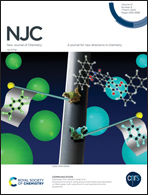Surface reconstructed polymeric carbon nitride with promoted carrier separation for photocatalytic H2O2 production†
Abstract
A high Frenkel exciton binding energy in a polymeric carbon nitride (PCN) usually restricts the charge carrier separation and photocatalytic applications. Surface engineering is a promising approach for photocatalysts in solar energy conversion owing to the mass transfer and photoredox reaction occurring on the surface. Herein, surface reconstructed polymeric carbon nitride (PCN-SR) is fabricated by a LiOH post-treatment method. X-ray photoelectronic spectra disclose that the surface of PCN-SR is filled with cyano groups, nitrogen vacancies and lithium. Surface reconstruction mediates the conduction band of PCN-SR (−0.36 eV). Therefore, PCN-SR exhibits excellent photocatalytic H2O2 evolution activity with a rate of 83.6 μmol h−1, which is 5.8 fold higher than PCN. Fluorescence spectra (PL), photocurrent plots and electrochemical impedance spectra (EIS) show that the improved photoactivity is attributed to the efficient separation and migration of carriers caused by surface reconstruction, thereby boosting the photocatalysis.



 Please wait while we load your content...
Please wait while we load your content...